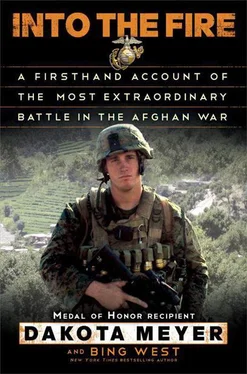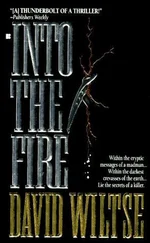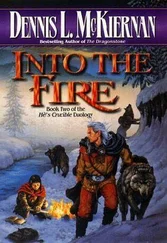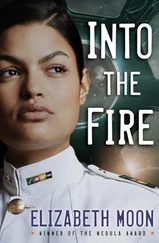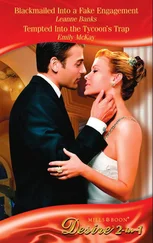Shooting another human being was a math problem. You were either right or wrong, with no subjective in-between decided by someone else. I liked problems that were black or white, life or death. Before taking a shot at a target one thousand meters away, you had to calculate the effects of the light air at altitude, wind, humidity, angle of fire, cartridge velocity, and gravity. You had to align the target, the background, the terrain, the weather, the noise, and the weapon. You had to work in concert with others. At the same time, the target enemy was figuring out how to kill you. Combat was zero-sum decision-making played for the highest stakes, live or die.
My final test was conducted at one thousand yards with the M40-A3. You get two tries. If you hit the man-sized iron target half a mile away, you qualify. My first shot missed. The school’s best spotter then gave me the data for wind and elevation. I squeezed off my last bullet. We all heard the distant ping of a good hit.
Thirty-one of us began the eleven-week course; thirteen graduated. Skinta gave us a short talk about that.
“I took no pleasure in washing out most of the class,” Skinta said. “I can teach anybody to shoot. I can’t teach personal discipline. The test of a sniper is his ability to convince a commander that every step in a mission has been thought through. A sniper is all about maturity.”
When we began the course, the instructors called us PIGs, or professionally instructed gunmen. At graduation, each of us received a neck chain with a single 7.62 bullet in a clasp. It was called the HOG tooth, or hunter of gunmen. I was now officially designated as an 0317—a sniper.
On my chest I had inscribed a tattoo in Latin: Vestri nex est meus vita , or “your death is my life.” My sniper instructor suggested I inscribe the Latin rather than the English translation; otherwise, people would think I was a lunatic. To me, the quote meant that I viewed the act of shooting in black-and-white terms. You either succeeded by hitting the target, or you failed and it’s his turn.
After nineteen months in the Corps, I was beginning to put it together. I knew that having a combat action ribbon wasn’t what made a good Marine. Instead, it was confidence based on good planning and execution, doing what was right time after time. I had learned from those who did it right, the Bradys, Kreitzers, and Skintas.
In July of 2007 our battalion assumed patrol duties in Kharma, sixty miles west of Baghdad. Nicknamed “Bad Karma,” the dingy town consisted of a few dozen narrow, dirty cobblestone streets lined with cramped concrete apartment buildings. A large mosque with a bombed-out minaret had been used by insurgents as a rest stop during the highly publicized battles for the nearby city of Fallujah. In the three years since then, the Marines had employed constant patrolling to grind down the local insurgent gangs. The town was so small that sooner or later, informants pointed out first one terrorist cell, then another.
When we arrived, we were hit occasionally by a few mortar shells from the diehards. Rumor had it they had only one tube. Four or five guys would drive to an open field, hop out, point the tube in the direction of our main compound, pop a few shells down the tube, and drive away.
We couldn’t detect a pattern or locate the source. We conducted little visits where a squad or a team of snipers would walk unannounced into a compound after dark, herd the startled family into one room, set up observation posts on the roof, sometimes staying for two days and sometimes leaving the next morning. We were hoping sooner or later to cross paths with the mortar team.
With each compound separated only by a wall from the next, sounds carried clearly down the streets at night. If you weren’t careful, soon the whole neighborhood knew that strangers were about. Once, at two in the morning, we sneaked over a back wall into a large courtyard. It was a hot night, and the family was sleeping outdoors. As we shook the owner awake and signaled him to be quiet, I saw a man next door staring at us in amazement. I gestured for him not to speak. That didn’t work. Inside a minute, his whole family was awake. So I shooed them into the courtyard next door.
“Meyer, what the hell are you doing?” my startled teammates asked.
The two families together made enough noise to wake up the family on the other side. Again, we herded a wary husband, an irate wife, and sleepy kids into the courtyard. Now we’d collected twenty-three Iraqi civilians, who were highly pissed at being awakened and prodded like sheep from one place to another. So, we apologized and walked back to base the next night, muttering at each other.
On night patrol, you couldn’t lie down anywhere in the fields without being bitten by sand fleas. One day I was stung sharply on my right hand. Over the next several days the swelling increased and my hand felt like it was burning off. It was a deep red, with other red streaks running up my forearm. My platoon sergeant brought me to the battalion doctor, who took one look and drove me to a hospital. I had been bitten not by a sand flea but by a recluse spider and now had a severe staph infection.
They operated twice in the next two days to save my hand. I was then evacuated to Hawaii. Two years of training for this?
For two weeks I couldn’t feel or move my fingers. The doctors recommended a gradual course of physical therapy over six months. I went enough times to understand the principle: exercise the fingers until sufficient pain kicked in to stop the treatment until the next day. I decided to replace the in-clinic daily visit with my own twice-a-day schedule. At first, I could only pull the fingers open like a pair of rusty pliers, with each creak bringing on a wave of fresh pain. So I started drinking Kentucky bourbon. I had nothing to do but drink and bend my fingers. I was knocking back a bottle to a bottle and a half a day, twelve thousand miles away from my platoon in Iraq and six thousand miles from where the bourbon came.
The doctors told me to go home for a week in October. I called Justin Hardin, who had played tight end on our high school team and was my solid, down-to-earth buddy—the calm one in our duo—and told him I was coming. He said we’d be sure to go to a football game or two and hit up a few parties. I was excited. Maybe a girl or two would remember me—maybe even Nikki. The doctors were right: just thinking about getting out of the barracks, hanging out where I knew everyone, made me smile.
That didn’t work out. Justin was killed in a car crash about three hours after we made our plans over the phone. His car slipped off a rain-slick road and hit a tree.
I was looking forward to going home for Christmas, hoping for some fun, but while home another old friend, Mary Kate Moore, smashed her car and she was gone, too, just after I had seen her pass on the road. I was hoping it wasn’t me that was such a good luck charm for my friends. When I was in high school, I had signed up for the track team, doing some sprinting and pole-vaulting, just to jog around the track with Mary Kate. She was a little bitty, peppy thing, and I had a real crush on her back then. Unbelievable. I never liked Christmas much anyway.
In the early winter of 2008, my battalion had returned from Iraq and I was back with them. My platoon sergeant, Gunnery Sgt. Hector Soto-Rodriguez, watched me for a few weeks and then laid down the law:
“Knock off the drinking, Meyer,” he said. “You’re a sniper, not a screw-off. It’s time for you to step up and be a leader.”
He put me in charge of a team and challenged me to build us into a top-notch fighting unit. I had a job to do that mercifully took up all my time.
Gunny Soto-Rodriguez sent me to the marksmanship coach course. After shooting hundreds of rounds, I could hit practically anything with a pistol or rifle. From there, I was sent to the mountain warfare center in Bridgeport, California, for the high-altitude sniper course. The center is located atop the Sierra Nevada range, 150 miles east of San Francisco. The spring scenery was stunning and the instructors were veritable mountain men. During the winter, the Marines up there survive in snow caves. In the summer, they scale rock faces at ten thousand feet.
Читать дальше
